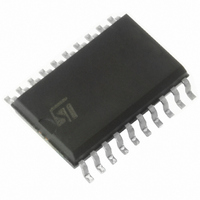ST72F623F2M1 STMicroelectronics, ST72F623F2M1 Datasheet - Page 71

ST72F623F2M1
Manufacturer Part Number
ST72F623F2M1
Description
IC MCU 8BIT LS 8K 20-SOIC
Manufacturer
STMicroelectronics
Series
ST7r
Datasheet
1.ST72F622L2M1.pdf
(139 pages)
Specifications of ST72F623F2M1
Core Processor
ST7
Core Size
8-Bit
Speed
8MHz
Connectivity
USB
Peripherals
DMA, LVD, POR, PWM, WDT
Number Of I /o
11
Program Memory Size
8KB (8K x 8)
Program Memory Type
FLASH
Ram Size
384 x 8
Voltage - Supply (vcc/vdd)
4 V ~ 5.5 V
Data Converters
A/D 3x10b
Oscillator Type
Internal
Operating Temperature
0°C ~ 70°C
Package / Case
20-SOIC (7.5mm Width)
Processor Series
ST72F6x
Core
ST7
Data Bus Width
8 bit
Data Ram Size
384 B
Interface Type
SCI, SPI, USB
Maximum Clock Frequency
12 MHz
Number Of Programmable I/os
11
Number Of Timers
2
Operating Supply Voltage
4 V to 5.5 V
Maximum Operating Temperature
+ 70 C
Mounting Style
SMD/SMT
Minimum Operating Temperature
0 C
On-chip Adc
10 bit
Lead Free Status / RoHS Status
Contains lead / RoHS non-compliant
Eeprom Size
-
Lead Free Status / Rohs Status
Details
Other names
497-2114-5
Available stocks
Company
Part Number
Manufacturer
Quantity
Price
Company:
Part Number:
ST72F623F2M1
Manufacturer:
NXP
Quantity:
670
Part Number:
ST72F623F2M1
Manufacturer:
ST
Quantity:
20 000
SERIAL COMMUNICATIONS INTERFACE (Cont’d)
10.5.4.3 Receiver
The SCI can receive data words of either 8 or 9
bits. When the M bit is set, word length is 9 bits
and the MSB is stored in the R8 bit in the SCICR1
register.
Character reception
During a SCI reception, data shifts in least signifi-
cant bit first through the RDI pin. In this mode, the
SCIDR register consists or a buffer (RDR) be-
tween the internal bus and the received shift regis-
ter (see
Procedure
– Select the M bit to define the word length.
– Select the desired baud rate using the SCIBRR
– Set the RE bit, this enables the receiver which
When a character is received:
– The RDRF bit is set. It indicates that the content
– An interrupt is generated if the RIE bit is set and
– The error flags can be set if a frame error, noise
Clearing the RDRF bit is performed by the following
software sequence done by:
1. An access to the SCISR register
2. A read to the SCIDR register.
The RDRF bit must be cleared before the end of the
reception of the next character to avoid an overrun
error.
Break Character
When a break character is received, the SCI han-
dles it as a framing error.
Idle Character
When a idle frame is detected, there is the same
procedure as a data received character plus an in-
terrupt if the ILIE bit is set and the I bit is cleared in
the CC register.
Overrun Error
An overrun error occurs when a character is re-
ceived when RDRF has not been reset. Data can
not be transferred from the shift register to the
and the SCIERPR registers.
begins searching for a start bit.
of the shift register is transferred to the RDR.
the I bit is cleared in the CC register.
or an overrun error has been detected during re-
ception.
Figure
46).
Doc ID 6996 Rev 5
RDR register as long as the RDRF bit is not
cleared.
When an overrun error occurs:
– The OR bit is set.
– The RDR content is not lost.
– The shift register is overwritten.
– An interrupt is generated if the RIE bit is set and
The OR bit is reset by an access to the SCISR reg-
ister followed by a SCIDR register read operation.
Noise Error
Oversampling techniques are used for data recov-
ery by discriminating between valid incoming data
and noise. Normal data bits are considered valid if
three consecutive samples (8th, 9th, 10th) have
the same bit value, otherwise the NF flag is set. In
the case of start bit detection, the NF flag is set on
the basis of an algorithm combining both valid
edge detection and three samples (8th, 9th, 10th).
Therefore, to prevent the NF flag getting set during
start bit reception, there should be a valid edge de-
tection as well as three valid samples.
When noise is detected in a frame:
– The NF flag is set at the rising edge of the RDRF
– Data is transferred from the Shift register to the
– No interrupt is generated. However this bit rises
The NF flag is reset by a SCISR register read op-
eration followed by a SCIDR register read opera-
tion.
During reception, if a false start bit is detected (e.g.
8th, 9th, 10th samples are 011,101,110), the
frame is discarded and the receiving sequence is
not started for this frame. There is no RDRF bit set
for this frame and the NF flag is set internally (not
accessible to the user). This NF flag is accessible
along with the RDRF bit when a next valid frame is
received.
Note: If the application Start Bit is not long enough
to match the above requirements, then the NF
Flag may get set due to the short Start Bit. In this
case, the NF flag may be ignored by the applica-
tion software when the first valid byte is received.
See also
the I bit is cleared in the CC register.
bit.
SCIDR register.
at the same time as the RDRF bit which itself
generates an interrupt.
Section
10.5.4.10.
ST7262xxx
71/139













